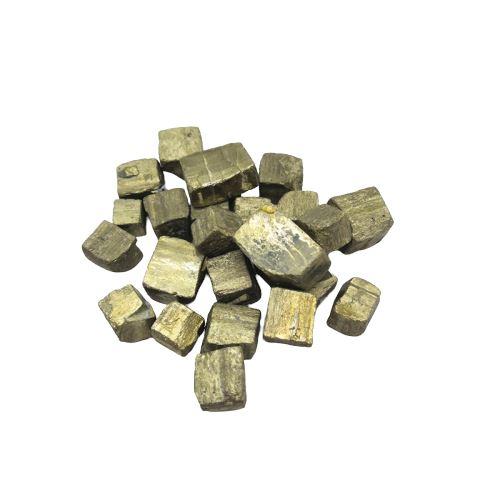Fool's Gold (Pyrite): Nuggets with Strange Powers
Fool's gold is one of the many nicknames given to pyrite, a mineral found underground in certain regions of the world.
When we see it with the naked eye, it can (as its name suggests) look like little nuggets of gold. It could well be that our stone’s nickname stems from this astonishing similarity…
Fool's gold thus has characteristics that are very different from those of kings' metal, whether from a physical or spiritual point of view.
Although pyrite is less rare and less expensive by weight than gold (like almost all materials that exist on earth, moreover), it has astonishing qualities which make it an ideal base for the creation of doors. -powerful happiness.
Contents :
Yes, fool’s gold is actually… pyrite!
Properties of this strange nugget

Yes, fool’s gold is actually… pyrite!
A rock or a crystal? An oxide or a sulfide? But what is this astonishing substance?
As we told you a few moments ago, this mineral called "fool's gold" is actually pyrite. This rich mineral species is an “ iron disulfide ”. It is therefore exploited both as a source of iron and as a source of sulfur. Sedimentary rocks rich in pyrite also often contain calcium, lead and copper.
Coming from the Greek word "pyr", meaning fire, this type of stone has been used for millennia now for its ability to produce sparks when struck against certain materials.
Pyrite was thus used throughout Prehistory and Antiquity to create fires around which women and men gathered.
This alone makes us understand the symbolic significance that this stone may have had.
Even more interesting, pyrite was used as early as the Renaissance for the manufacture of firearms, in which it was used to create the spark that would ignite the powder.
Through its history, fool's gold thus carries within it values such as those of gathering and creation of community, but also of defense, protection and combat.
Properties of this strange nugget
Without too much surprise then, pyrite has long been considered a powerful lucky stone capable of ensuring the protection of those who carry it (whatever their form).
In particular, many doctrines describe it as a dissipator of negative energy and a source of stimulation of our inner well-being.
This may seem a bit "vague", but that's in summary what we found about it.
Another interesting thing to say about fool's gold is its ability to activate the Hara and solar plexus chakras, thus strengthening our strength of mind as well as our will.
From Native Americans and Chinese, to many cultures around the Mediterranean: lucky pyrite has also demonstrated certain healing capacities (particularly emotional) which have appealed to various peoples.
In summary, we are talking here about a simple ore capable of:
- Protect yourself from bad energies with a shielding action
- Strengthen your positivity and strength of character
- Think about certain types of wounds
- Boost your happiness
- And many more
As much as it may seem at first glance, you now understand better why the pieces of fool's gold that we make available to our community here are meeting their small success!

History and legend of fool's gold
We mentioned it in the introduction but, in fact, one of the characteristics of lucky pyrite is that it resembles gold. .. and certainly at first glance, to the untrained eye.
It is true that the material we are talking about has a characteristic yellow color and a shine which, in a certain light, can be quite deceptive.
We therefore understand why the nickname of pyrite speaks to us of gold, but why is it a question of fools?
Well in fact, the numerous prospectors during the “great gold rush” (a period in the American West on which you will find more information here ) saw many unfortunate people sink into madness following bad jokes what fate did to them.
While the researchers thought they had found enough gold to ensure their wealth until death, some could not bear to see their precious hoard appraised as being made of pyrite nuggets, and therefore as being less expensive.
Another opinion would have it that fool's gold takes its name from those who allowed themselves to be deceived by it.
As we told you, this ore resembles gold, but still has characteristics (such as fragility or color tints) which normally allow you to differentiate it in a few seconds.
Clearly, to be fooled, you really had to be crazy.
These first two hypotheses are amusing and, if you ask us, entirely relevant.
However, there is a third, much deeper…
You should know that pyrite and gold tend to appear in the same deposits.
However, when some prospectors found fool's gold, they were so disappointed that they did not try to dig further, sometimes missing out on the jackpot!
Our lucky stone would thus hide within it a message of perseverance and an invitation to never give up... Interesting!
The use of fool's gold in jewelry
The last thing to know about our stone and the importance it may have had in jewelry throughout history.
The ancient Greeks already created magnificent ornaments and decorated their temples with it.
The Incas, for their part, saw it as a sacred metal that could only be worn by priests and kings.
Closer to home, fool's gold was particularly popular in 19th century Britain.
It is also interesting to note how, for centuries, costume designers have used it to replace gold, which is far too expensive, in theater or cinema outfits.
Today, however, its main use will remain as a good luck charm and protective material reinforcing the powers of certain esoteric signs and symbols.
If you are looking for a lucky jewel with special powers, a good starting point could be this page bringing together our different pendants.
Lucky charm featured in this article

Piece of Fool's Gold
See more


